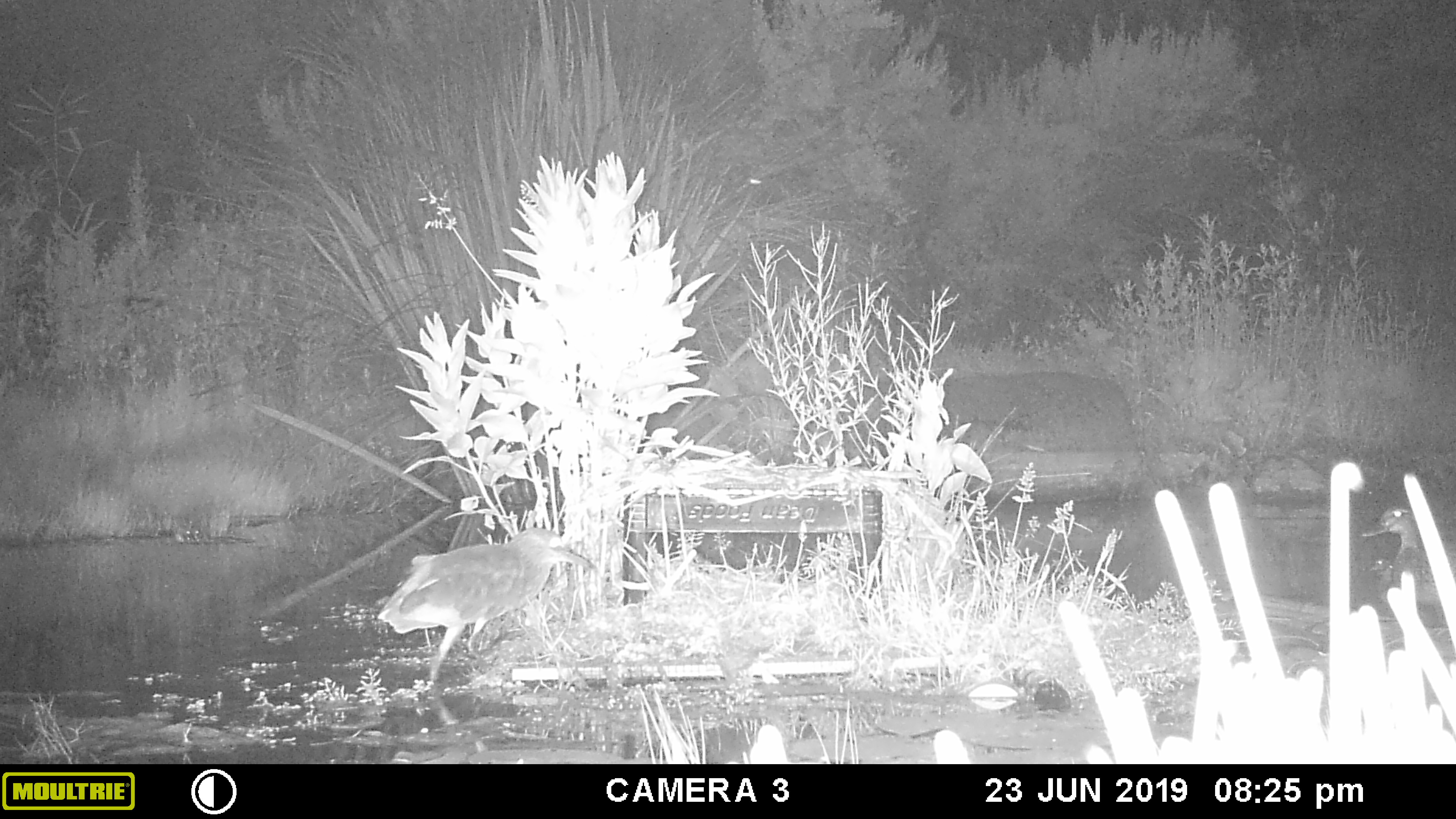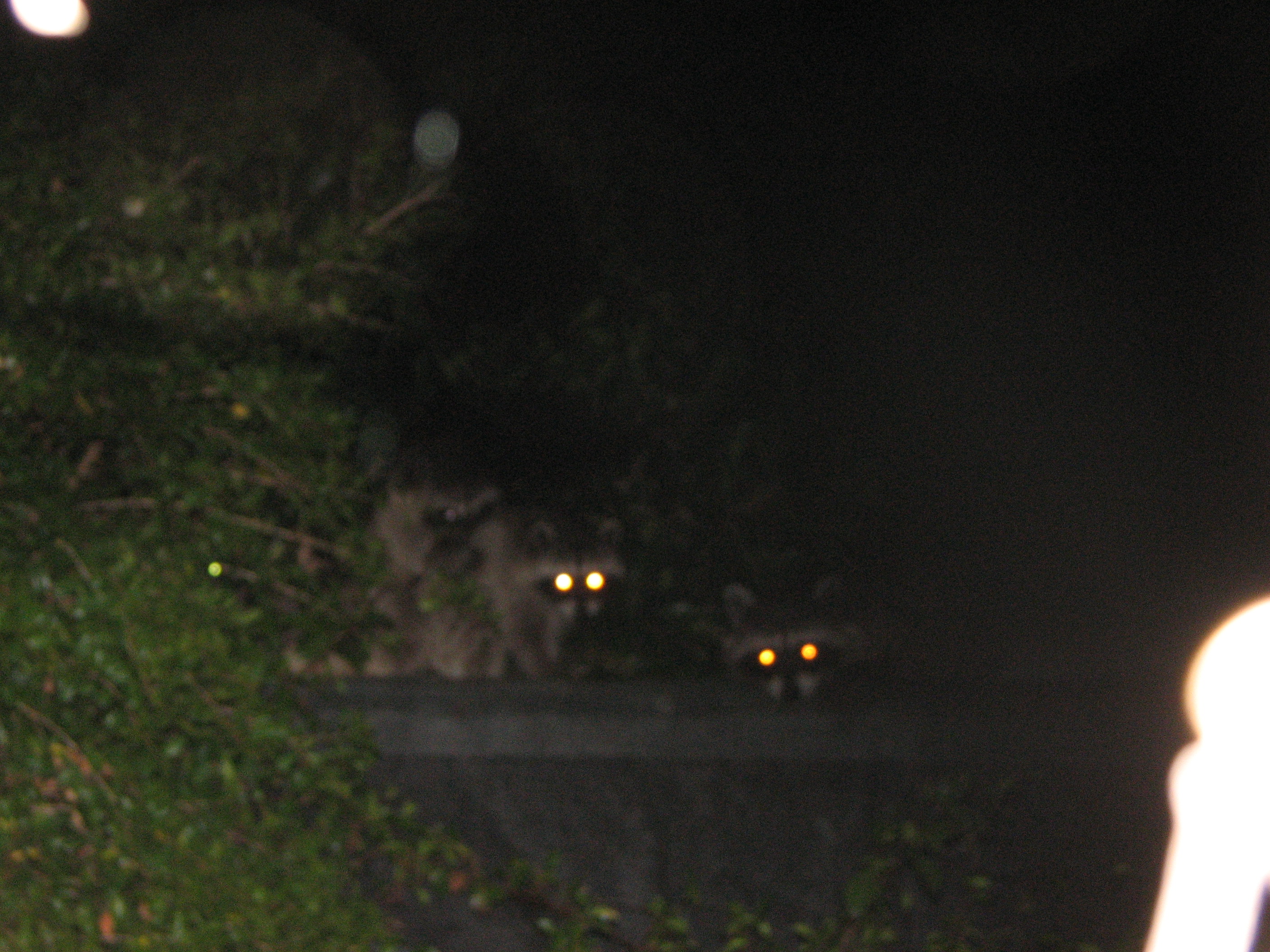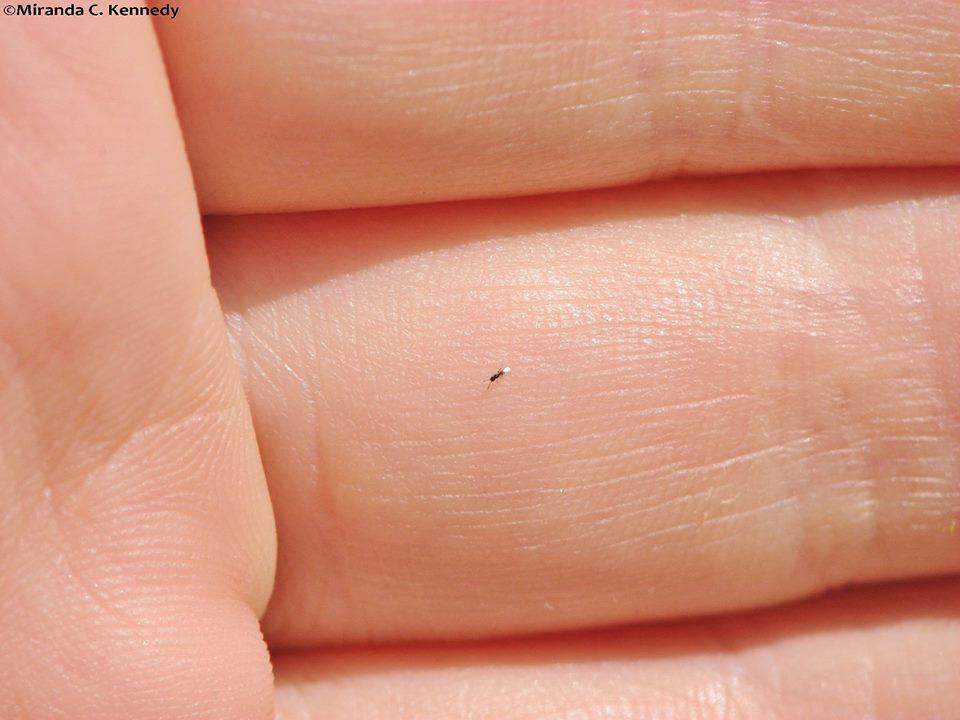- Gardening adventures, Permaculture and Edible Forest Gardening Adventures, Photos, Vegetables, Vegetarian
My Gardens Today
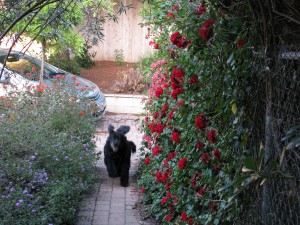
Entranceway with Running Dog April and May are months that I often don’t remember when reflecting back at the end of the year. Spring is such a busy season. When I was raising children, and when I was working as a school librarian, these months rushed past in the haste towards summer break. As a gardener, Spring is one season when I turn into one of those Garden Designers London and since it is also the season of intense growth of both weeds and desirables, insects and increasing dryness, and for me and so many others, the inevitable allergies that keep me out of the garden for days. So I thought I’d post photos of my gardens as they stand today, in the middle of April, on threshold of Summer.

By the Front Door I’ll start at my front door and work downhill. The walkway to the front door is lined with purple lantana and a mixture of red geraniums, honeysuckle, butterfly bush and Double Delight rose. It is being enjoyed by my very silly old dog General Mischief, who just realized that I was going to let him into the house. He looks a bit like a vampire dog in this photo, though!
By my front door I have a collection of miscellaneous plants, as most people do. Two staghorn ferns given me by my mother have attached themselves in a very satisfactory way to the chain link fence. There is also a dark red ivy geranium, needlepoint ivy, some bulbs just out of bloom, a traveling (or Egyptian) onion (it’s seeds are bulbets grown on the flower) that my brother gave to me, and some sedums. When I water here I usually disturb a Pacific Chorus Frog or two. I’ve thinned and weeded and replanted this collection, but there are always more that magically appear.
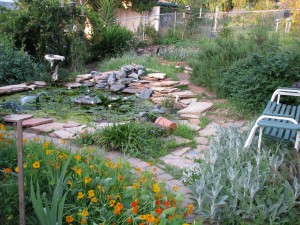
Front Pond The front yard pond is full of algae, but that is all right for the moment. I don’t want a crystal clear pond; I want habitat. Because of the clear blobs of frog spawn and wriggling tadpoles hiding from the hungry mouths of the mosquito fish I keep the algae until it is no longer inhabited. Waterlilies (even the monster one! Look at other posts for an explaination) are blooming with last weekend’s sudden heat. In the foreground are Jewel Mix nasturiums with heirloom tuberoses emerging, a grey mound of lamb’s ear which has begun to pop up where I don’t expect it, and rosemary by the bird feeders. Our kitchen table has the view of the feeders, and it is from this yard that we count birds seasonally for Cornell University’s Project Feederwatch. Oh, and try not to focus on the weeds, please.
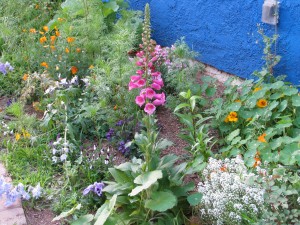
Side Gardens On the South side of my house I’ve painted the wall a Mediterranean blue to reduce the glare and create a colorful backdrop for flowers. I keep annuals in this bed, along with some bulbs and a rose that is still small that my daughter gave to me. In th photo just blooming are naturtium, alyssum, foxglove, pansies, and a delphinium that fell over and started growing upright again. My library window overlooks this yard. I was trying to keep the color scheme focusing on apricot to show up well agains the wall, but I end up planting whatever I want in here. Cosmos have again reseeded and are starting to grow rapidly; they’ll block the window by summer and be full of goldfinches. I’ve also planted a couple of bleeding hearts that I picked up in one of those bulb packages at WalMart. Usually the plant is pretty spent and they aren’t worth the money, but I somehow think that I am rescuing the poor thing. These came up but haven’t yet bloomed.
Lady Banksia Along my driveway is a Lady Banksia rose that has taken off, along with a bush mallow, a Hidcote lavender, and a late daffodil. Farther along the driveway (not shown) is a Pride of Madera (I love that name!) that is going gangbusters, a small liquidamber, rockrose, a mixture of natives and incidental plants such as a tomato that survived the winter, a Joseph’s Coat rose, and an established pine tree with a crow’s nest at the top. There are other roses and plants here, too, like a prostrate pyracantha for berries, a white carpet rose, native milkweed for the Monarch butterflies (perennial ones; the annuals are usually gone by the time the butterflies migrate here), an apricot penstamon, aloe vera, and probably the kitchen sink, too, if I root around long enough. I love tinkering around with this mess of plants, seeing what will grow and trying new combinations.
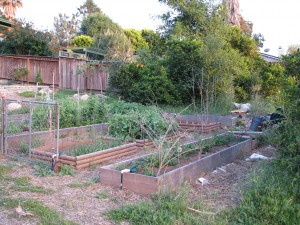
Raised Vegetable Beds In my raised vegetable beds the peas have been producing well. The shorter ones had been nibbled by crows as they were emerging, but after I put a rubber snake amongst them, the nibbling stopped. Potatoes are nearing harvest time, and I’ve already snuck out a few new potatoes and they were very good. Sometimes I’ve had potatoes with brown fiber in them and a bitter taste; no doubt due to irregular watering and soil problems. I worked hard on improving my soil and giving it a boost with natural fertilizers from Gardens Alive. There are so many peas in the garden because I planted all my old packets so that the roots will set nitrogen in the soil.
I also have growing carrots, broccoli, cilantro, parsley, endive, salad mix, parsnip, strawberries, blueberries, breadseed poppies, horseradish, asparagus, bush beans, fava beans, a yellow tomato and a red slicing tomato, garlic, shallots, red and white onions, Swiss chard, leeks, collards and basil. Most are just small guys right now.

Seedlings In my temporary nursery area I have sprouting pickling cucumbers, zucchini, quinoa (first time!), more basil, Dukat dill, cantalope, and a cooking pumpkin. I’ll sprout more squashes and maybe popcorn and sweet corn soon.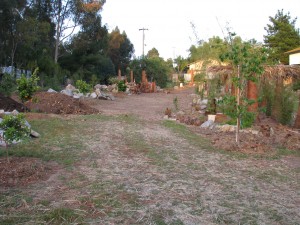
View up the Middle This is a view of the middle of my property, from the lower end up.
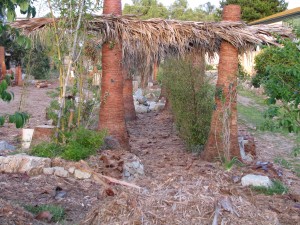
Palm Tree Walkway This is the palm tree walkway as it stands now.

Pre-Pond And this is the lower area. Notice the stakes in the ground and the tractors? They are there because today is the day the ponds will be excavated! The rain-catchment ponds, permanent habitat pond and swales will be carved, shaped and filled in the next two days, fed by water from a 4-inch well augered in the lower property. I have hired Aquascape to create habitat and rain catchment ponds; the demostrations of their work look as if humans hadn’t messed with anything. In about an hour from now, the action finally begins! After the ponds are installed, then the final plant guilds will be established, the minor amount of irrigation installed, and that will be that! I’ll keep you posted on pond development! -
Permaculture Garden Update
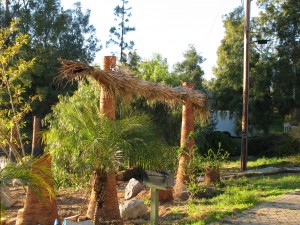
Entrance Lots of hard work is being done on the property, and the garden is taking on character. Bits of the palms that were cut down are being used in so many ways. The upright trunks that were left have been stripped, and metal poles were tied between them. I didn’t care for the look of the poles, so Roger immediately came up with the idea of wrapping them with palm fronds… and it looks great. The above photo is of the future ‘formal entranceway’ to the garden. Francisco and Juan were working from the tops of ladders in full sunlight on this unseasonably hot day… it must have been over 90 degrees out there. Summer weather too early! I’m glad that it is going to cool down a little starting tomorrow.

Arbor They also covered metal poles that they criss-crossed the trunks in the palm walkway. Up all of the trunks are a variety of flowering vines, and also climbing heirloom roses. I ordered the roses from Heirloom Garden Roses (http://www.heirloomroses.com/), and the plants are small but healthy and virorgous. I made little cages out of leftover chicken wire from the chicken tractor to set over them; otherwise, the bunnies would nibble the young rose leaves down to nothing. Beneath the palms, many plants that will create the plant guilds are in the ground and mulched with chipped palmsand surrounded with rocks. Rocks have also been placed around the property to add character and interest. The palm sheaths that were skinned from the trunks will be used on top of the mulch as a secondary layer; its interesting to look at, is textured and therefore makes interesting hidey-holes for lizards, salamanders and all sorts of creatures. Most planting will now cease until the important decisions about installing the rainfall retention ponds, dry creek beds, swales and the permanent (swimming?) pond are made. We met with more people this week about the pond installation and are awaiting bids and ideas. I’m looking for the most sustainable, least impact and easiest way of installing them, and we may have found a company that understands this. More about the ponds when decisions have been made.
Other work has concentrated on the embankment and the erosion areas there. This is the area below the fence; the embankment with the streambed is on the right, and the main property is beyond the upper left corner of the photo. This area had been leveled, firmed, mulched, and old broken pipes and wires that had been a junky retaining wall was replaced with old chainlink fencing and aluminum from the sheds. Then palm logs were used to line the cut-out area around the left to help hold the soil. Palm fronds were installed all along the top of the chainlink on the right…

Erosion area and also on the next level which is in the process of being firmed, repaired and made available for bird watching, including a very
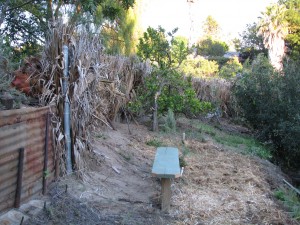
- Lower level
handy bench. This area had been greatly eroded, especially by the December deluge. An enormous toyon has tipped over and its roots are exposed on the embankment. From this vantage point out over the embankment my daughter and I could watch a lot of birds flying between the canopy of the streambed trees. You can see from this photo also how the palm fronds have been used to block the lower side of the fence. In the bottom left corner is some of the old corrugated aluminum that had been there from the previous owner, and which is still holding up. It will be blocked by fronds as well. Past this point and around the corner is a big erosion area which ends the pathway. It is being worked on. With the ponds, streams, mulch and swales in place, as well as these bulwarks of wire and aluminum, the chance of such heavy erosion happening again even in the worst rainstorms is almost nil. The property will be augmented to deal with excessive waterflow as well as insufficient amounts.
I am still tossing around ideas about buildings to replace the sheds. I need a tool/mower storage shed, a small ‘bee house’ where we can store our bee equipment and work on honey extraction without the bees bothering us (we’ve extracted honey in our kitchen), and I’d like a small greenhouse or growing house for seedlings. I also would like small building or trailer that could be used as a guest house, as well as an area for groups of people to gather for teaching purposes. I’m getting prices and ideas on how to do all this cost-effectively. I’ve looked into Quality Sheds in Menifee, asked the carpenter who did my other projects to give me a bid, and have researched trailers, yurts, geodesic domes, straw bale… everything. So many decisions! But how fun it all is. That’s all for tonight, and thanks for reading. -
Gardens Taking Shape
The recent abundance of rain is wonderful, and I surely wish that the catchment ponds and swales were in place to capture what is running off my land. However, with the newly planted trees and tilled soil some of it is percolating down instead of flowing out. The rain has also slowed progress to some degree, and the soil is too wet for any large vehicles to drive on. Our next big issue is: water. How best to capture roof run-off, greywater, watershed, and how to keep it until its needed in the hot, dry days of summer. In the coming week we’ll be talking to many authorities on water to come to a sensible solution that fits in with the tenets of permaculture. For one thing, this rainy winter probably won’t be repeated often, and so less water will be filling the swales. However, as the loam deepens and the plants mature, less and less water will be needed until the property takes care of itself. That’s the goal, and it has been done successfully elsewhere.
Meanwhile, tomorrow morning I drive my daughter back to Oregon State University (Beavers, not Ducks!) and I’ll report from the road.
A lot of planting and shaping has been going on despite the rain, and the garden is taking shape. As I walked down yesterday evening, I had the feeling that the property was larger, because there were pathways and destinations gradually emerging. It was an interesting feeling, that I couldn’t take in the property in one glance around anymore. The destruction phase is in the past and a new life has begun to emerge. For every garden has a character – a personality. It is more than the feeling you get from being in it. It is the interaction between ponds, soil, shade, plants and all the animals and insects that call it home. All that nuance and chemical exchange that makes a habitat. With permaculture, humans fit into the puzzle, not as lords and masters but as part of the interaction. It is a wonderful feeling to enable a garden such as this, which will be organically teaming with life from soil microbes to circling raptors, and not feel as if I were intruding.
Here are some photos of the progress:

Skinned palms The palm trunks that have been left standing were painstakingly skinned to create a different effect (rather than just a beheaded palm tree!).
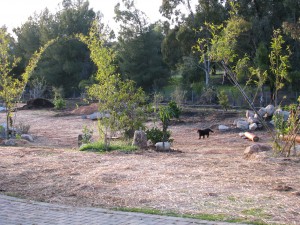
Arching bamboo Bamboo not only will supply building materials, but it provides upright, arching interest in the garden. Some rocks have been placed near planted areas as focal points and resting spots. All around the fruit trees and bamboo are smaller plants, which are the beginnings of the plant guilds which will become much larger and take up most of the property. The palm logs and piles of boulders are awaiting use in the rain catchment streams, ponds and swales. Our dog, General Mischief, is making sure the garden smells right, in his own special way.
Entrance-way This is the entrance-way to my front door. The geraniums climb up a chain-link fence on the left adding vivid color most of the year. There is also on the other side of the fence a pyracantha, a honeysuckle, a Double Delight rose, and a purple butterfly bush that I’m training to arch overhead. Once in a garden in Hawaii I walked through a tunnel formed by two butterfly bushes planted close together. I don’t want to remove any of the lantana that lines the right side of the path because it is such a great nectar source for butterflies, so I just have the one butterfly bush. I’m not bothered by the low branches because I’m short, but my visitors often have to duck. As it fills in I keep pruning it higher. If you see something brown by the front door, that would be my other dog, Sophie, who wants back on the couch even though the weather has cleared and it is warmer. So spoiled!
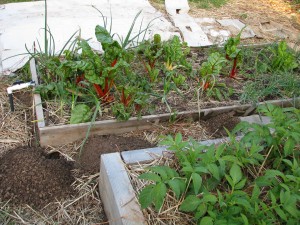
Frustrated gophers These are the holes of a frustrated gopher. My raised garden beds I constructed out of old unpainted bookshelves and lined the bottoms with aviary wire. In the top bed is Swiss chard, shallots and garlic. In the bottom bed are white and red potatoes. Sorry Charlie!Tomorrow starts early for a long car trip, so I’ll say good-night now. I’ll keep you posted! Thanks for reading. -
Chicken Tractors
To most people a chicken tractor sounds like some lame joke. Until fairly recently, I did too. However there are whole websites devoted to them. And as of this week, thanks to local carpenter Jay Tull, I am the proud owner of one!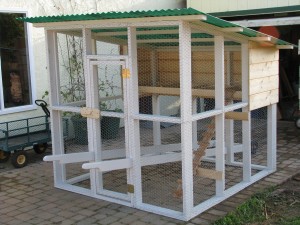
Chicken Tractor One of the fundamental ideas of permaculture is a holistic approach to land management and food supply. Keeping animals that produce food in a compassionate, healthy and useful manner is part of the puzzle. I am a lacto-ovo vegetarian and want dairy products that are produced using humane methods. Therefore, a chicken tractor! A chicken tractor is a movable coop with an unlined bottom. The chickens root around eating bugs, digging up weeds and pooing within the safety of their lovely tractor. You throw in some straw and they mix it into the soil and poo on that, too. In a few days or a week, that square of soil has been dug up, mulched and fertilized and it’s time to move on! So you move your tractor, chickens and all, to wherever you would like them to work next. Meanwhile you collect enriched eggs that have been laid by unstressed chickens who supplement their mash with bugs and greens out in the fresh air.
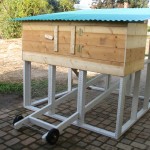
Back view If you have ever eaten eggs from backyard chickens, it may take a little getting used to. That is because the flavor is so interesting and fresh. Going back to supermarket eggs is like switching from chocolate to carob: as a satisfying substitute it just doesn’t fit the bill.
Chicken tractors come in all shapes and sizes. Check out these images: http://home.centurytel.net/thecitychicken/tractors.html. I must admit that my chicken tractor turned out heavier than I’d like, but it’s beautifully made and I’m very happy with it. We’ve joked about entering it in the Christmas parade. If you’re interested in chicken tractors (or chicken arks as they are also called), read Chicken Tractor: The Permaculture Guide to Happy Hens and Healthy Soil by Andy W. Lee. The San Diego County Library system has copies. (Did you know that you can order books from any County library online and it will be shipped to your local library? Visit https://dbpcosdcsgt.co.san-diego.ca.us/search).
This tractor is large enough for maybe four or five chickens at most, which would provide more than enough eggs for me. There are hundreds of web pages that focus just on chickens, and a handy chart that lists egg-laying characteristics can be found here http://www.mypetchicken.com/chicken-breeds/breed-list.aspx, as well as other places. Many birds lay brown eggs or bluish eggs; they don’t have any difference in any respect than white eggs other than shell color, so to pay more for brown eggs at the supermarket is criminal.
Oh, and of course, if there is a chicken tractor, there must be chicks:
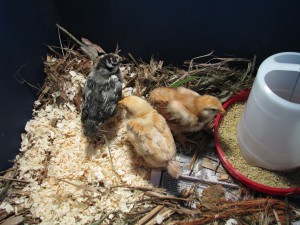
Two week old chicks These three ladies are two weeks old, and are from left to right a Silver Wyandotte, a Buff Orpington, and a Rhode Island Red. I want an Ameraucana (which is a hybrid of Aurucana, which lays the greenish and bluish eggs), and a Barred Rock, which is the traditional black and white chicken, but there were none to be had today as they are very popular. When some become available I’ll raise them seperately until they are mature and introduce them to these three so there is no bullying. Chickens lay eggs without a rooster, and do quite well without being harrassed and pecked at, too. My neighbors wouldn’t forgive a rooster, either. Right now my little chicks are too young for the Tractor, so they live in a Rubbermaid 50-gallon storage container with a 60-watt lamp on one side, water and mash in separate containers, newspapers and shredded bark underneath, and wire across the top because they are Chickens make wonderful pets and have a welcome spot in any permaculture system. Besides, they’re very cute.
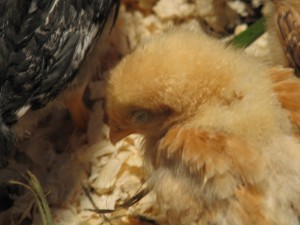
Sleepy chick (Photo credit: Miranda Kennedy)
- Birding, Gardening adventures, Heirloom Plants, Permaculture and Edible Forest Gardening Adventures, Photos
Brief Garden Updates

Palm Throne I spent the day making two birthday cakes for my two children, both of whom will be flying in from different directions tomorrow. Recipes will be the next thing I post! So for now, just a few garden updates. As you can see in the photo above, I have yet another palm throne, this one at the entrance to the garden. These are so fun. As the palms decompose, I can always plant in the seat!

Six loads of rock A total of six truckloads of rock have been delivered, and are piled in various areas on the property. At about 12 tons a load, that’s over 700 tons of rock! These will be used to surround the ponds, line the dry streambeds, and as interesting features in the natural garden.

- Garbage Can Enclosure
Jay finished the enclosure for the garbage cans, and it is pretty ritzy. Those incredible hinges are hand-made and you can see the imprint from the blacksmith’s tools on them. Jay had several sets and I had to have them. I go nuts over skilled craftsmanship, such as woodworking and metalwork. Right now there is only a latch on the outside, so it would pay not to close the door while inside. It would be a little climb and a long reach to get out again.

- Frond Fence
Along the radically improved and stabalized area above the embankment, some of the chain link and posts used to hold the soil were showing. So today lots of pond fronds (hey, we have a lot of them!) were being attached to the exposed fencing as camafloge. It looks great in that area. Also, little birds like house wrens love nipping between old palm fronds, and they’ll provide some hiding areas for the Western fence lizards, too. The stairs were made from railroad ties, and the area around them planted and then mulched with palm chips.
In the bulb beds, one of my favorite daffodils has opened today, and unfortunately I was snapping photos in the evening and the close-ups were blurry.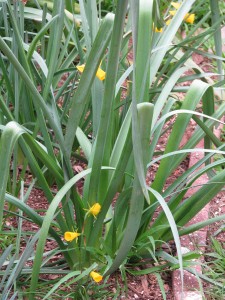 At the bottom of the bulb photo are Hoop Petticoats, and at the top, Little Witches, which I wrote about the other day. The little center unruffled hoops are so unique; besides Rip Van Winkle (which haven’t bloomed yet) these are my favorite.Also, Double Delight rose has bloomed. It is a double delight because its coloration is gorgeous and ranges from almost pure reddish pink to almost all white with some red on large, softly ruffled blooms. It also is extremely fragrant; my daughter said that it smelled the way rose water tastes, and that is perfectly true.Meringue Mushrooms coming up soon!
At the bottom of the bulb photo are Hoop Petticoats, and at the top, Little Witches, which I wrote about the other day. The little center unruffled hoops are so unique; besides Rip Van Winkle (which haven’t bloomed yet) these are my favorite.Also, Double Delight rose has bloomed. It is a double delight because its coloration is gorgeous and ranges from almost pure reddish pink to almost all white with some red on large, softly ruffled blooms. It also is extremely fragrant; my daughter said that it smelled the way rose water tastes, and that is perfectly true.Meringue Mushrooms coming up soon!
-
Permaculture Update
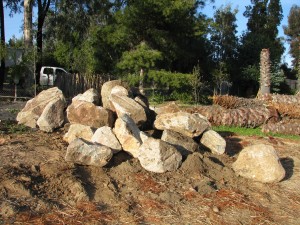
A Pile of Rocks As promised, I have more photos for you. Roger and his team have worked with all stops out for this last month and a half. Lots of heavy labor, skilled work and planning has been done. One of the big decisions that needs to be made next is about water. Besides digging a couple of unlined rain catchment ponds, which will perculate run-off into the soil and be dry most of the year, should there be a lined pond that would stay wet all year for birds and other wildlife. This pond would be cleaned by filtering the water through a bog area. Also, should I invest in a huge above-ground water tank to collect the thousands of gallons of water that pours off my house roof during rainstorms? So we are interviewing pond builders, and having pow-wows with other professionals who know about water.In the meanwhile, many trees and small plants have been planted, about half the pile of urea spread and tilled in.
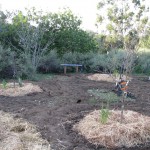
Tilled and mulched I am not an advocate of tilling in healthy soil. It tears apart the microbes and underground inhabitants that are what changes dirt into soil. About twelve years ago when I first moved here, I succumbed to those enticing Troy-Bilt tiller ads and purchased a 6 HP tiller; an enormous investment at the time, but with all this weedy property I thought it would help me ‘fix’ the soil. The tiller came dismantled. After a lot of trouble putting it together and getting it running, the machine I bought turned out not to be a tiller, but a device that endeavors to separate your arms from your torso and dislocate each vertibrae in your spine, all without actually tilling anything. The Troy-Bilt ad photos that show a neatly dressing young woman casually standing by her tiller pushing it with one hand, leads one to believe that the tillers are easy to run. Actually, the lady in the photo is having a good time only because the tiller isn’t turned on! She’s leaning on it! Someone made all those groves in the dirt with a hoe, because that tiller sure didn’t! You may surmise from that rant that I didn’t have much luck tilling, so the machine sat in my shed until recently. It was just repaired and yesterday, having been starved for so long, it tried to eat Roger as he used it around my property. Roger is a big, strong man, so I don’t feel so badly about having been so unsuccessful with using the tiller that I wanted to chain it in a dark celler where it wouldn’t hurt anyone again. Despite the evil tendancies of this machine, much urea has been tilled in around the planted trees, which is the first layer in the plant guilds that form the edible forest garden. Under the trees, other components of the guilds are being planted. Those components perform what roles plants in a natural forest hold: mulchers, groundcovers, shade, insect-attractors, nitrogen-fixers, and nutrient-miners. The guilds will grow larger as the project unfolds.
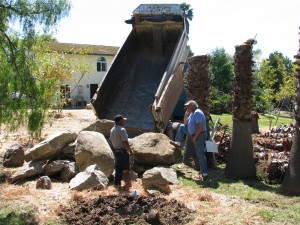
Jose and Roger with the first load of rocks Rocks are a wonderful focal point in any garden, and we needed a lot of them. With predicted rain this weekend, and the probability that the 10-wheeler wouldn’t be able to access the yard with the soil any softer, sped up the delivery date to… ASAP. Two deliveries of boulders were deposited today, and starting at 7 am tomorrow, several more loads will be dropped. I can just see all the lizards on the property rubbing their little hands together in anticipation of a great king-of-the-hill push-up contest. Two sections of my wooden fence had to be disassembled so the truck could pull directly into the yard. Later, the boulders will be placed with a small Bobcat. This is a nice mixture of rock, and this first load pictured shows the largest of the boulders. This is about 12 tons of rock. I can’t wait for time alone to go climbing! 🙂
I asked Roger if he knew a really good carpenter to help build some items for me, and he did. Local carpenter Jay Tull was brought into the job and is also a craftsman of skill, inspiration, problem-solving, and a lot of fun ideas. He made two top-bar bee hives first of all (I’ll go into bee hives in another post, as well as my blue bee garden), using almost all leftover materials on the property. They are beautiful. Next, I wanted to build a little fenced area to block off my trash and recycling cans so my long-suffering neighbors didn’t have to look at them anymore.

Garbage Can Closet or Guest House? So with lumber and more of that broken concrete (which actually came from his property!), he and Roger’s team are working on an incredible enclosure that probably should be a guest house! The walls, made of leftover fencing, and a gate will be added probably tomorrow after the cement all dries. Jay suggested that the cement chunks be cemented in rather than surrounded with gravel for easy hosing down. There is room for a planter on the side! Another project Jay is working on concurrently is a chicken tractor.
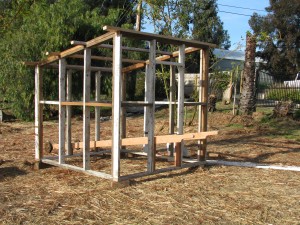
- Chicken Tractor in the Making
There are many websites devoted to just images of chicken tractors. These are portable chicken coops that rest on the ground. The idea is that the chickens root around in the ground weeding, pooing, eating bugs, etc., which is all extremely healthy for the birds and great for the soil. Then in a few days you move the tractor a little ways and set it down and they start on a new batch. I found a photo of one I liked, and Jay is building it almost entirely out of used wood from my old sheds, and wheels off my old gate. It works like an extremely heavy wheelbarrow; apparently the image I gave Jay to work from used two people to move it, but he’s adapted it for one person. I’ll show you the finished version in a couple of days. We’ve already joked about entering it in the Fallbrook Christmas Parade.
Other things that have been going on are the building of benches and seats for viewing areas around the property, using the materials that are here.
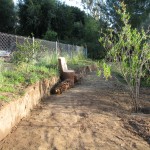 Jose and Francisco, Roger’s team, have stripped some of the palm trunks and cut them into chairs. This shows one set up on the newly repaired erosion area just above the barranca. Along the fence are planted more stonefruit, and on the other side of the fence are planted berry vines. The seat overlooks the mature toyons, sumac and willows that grow down the embankment, and a great place for bird watching. A garden isn’t a garden if there aren’t resting places for you to just sit and listen.
Jose and Francisco, Roger’s team, have stripped some of the palm trunks and cut them into chairs. This shows one set up on the newly repaired erosion area just above the barranca. Along the fence are planted more stonefruit, and on the other side of the fence are planted berry vines. The seat overlooks the mature toyons, sumac and willows that grow down the embankment, and a great place for bird watching. A garden isn’t a garden if there aren’t resting places for you to just sit and listen. 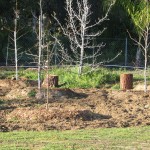 Stumps along the Liquidamber Allee
Stumps along the Liquidamber AlleeToday Roger saw an adult kingsnake under the native plants on the embankment, and it startled and slithered away. I think this may be our annual visitor to our upper pond and birdbath. Every summer he shows up once or twice looking for mice and getting a good long drink from our pond, then disappears. I’m hoping he has his eye on our gopher population.

California Slendar Salamander So the loud machinery, sounds of screeching rocks sliding on metal, and the whiff of urea continues on my usually quiet and unobtrusive property. Some day in the near future it will again be quiet, and all the animals I’ve scared off will return. Actually, many birds have been enjoying the piles of brush, and Roger has encorporated some brushy piles into the design just to allow the birds and bunnies and lizards small havens.
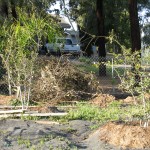 These piles are small, and are located well away from the house so as not to cause a fire hazard. Also I was sorting through the stack of old plywood on the weekend and uncovered two California Slendar Salamanders. One was larger than the other, so I think that was the female. I removed them to my upper pond area so that they wouldn’t get squished. These wonderful discoveries of life on my property make me all the more determined to complete this project in as a compassionate and organic way as possible.
These piles are small, and are located well away from the house so as not to cause a fire hazard. Also I was sorting through the stack of old plywood on the weekend and uncovered two California Slendar Salamanders. One was larger than the other, so I think that was the female. I removed them to my upper pond area so that they wouldn’t get squished. These wonderful discoveries of life on my property make me all the more determined to complete this project in as a compassionate and organic way as possible. My two elderly dogs, Sophie and General Mischief, have been having such a hard time of it. They lived their lives here outside, sleeping on an old futon in a small garage-type building. Now that they are both deaf, and Sophie likes to sneak out to go visit my long-suffering and wonderful neighbors, I’m afraid of them being injured with the gate opening and closing and large trucks pulling through. So, for the first time in their lives, they’ve had to adjust to living in my library on a sheet-protected couch. You can see how hard it is for them:
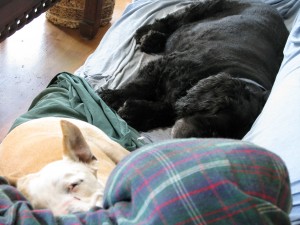
Suffering Couch Potatoes -
Garden Update 3-8-11
We had another good rainstorm last weekend that helped all the newly planted trees, but it also made driving on the dirt impossible again. Work has gone on almost daily, however. Roger and his crew put in long, strenuous days, and Roger is a wealth of inspiration and resources (to remind you, he’s Roger Boddaert, Landscape Architect and the Tree Man of Fallbrook.) With the rains came a little more erosion although the temporary covering of straw worked very well for retaining the topsoil. The crew have been working on the embankment leading down to the streambed. This is a photo of the area as it has been for many years. The previous owner used whatever bits he could find to shore up the property: for recycling he gets a 10, but for beauty he gets a zero.
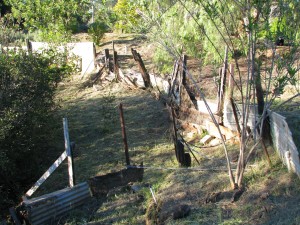
Using a chain-link fence that I had extra, corrigated aluminum from the demolished sheds, and lots of hard labor, the area now looks like this:
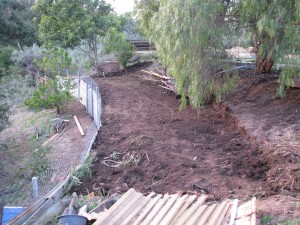
The chain-link won’t ever rot, and will provide an excellent trellis for climbing plants which will help hold the soil.
Do you remember all that free broken concrete I mentioned awhile back? The crew has turned it into two magnificent garden features:
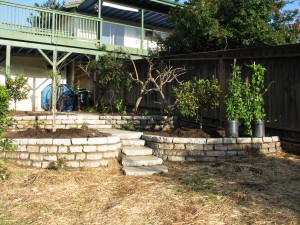
This tiered walkway has turned an old RV parking spot that had enormous grass-covered gopher holes (made huge and dangerous by my dogs trying in vain to find those gophers) into a wonderful garden area. It looks great from any angle, especially down from the ‘poop deck’, as I call the porch extension above. Kumquats, passionvines, redbud and dwarf peach trees live here now.
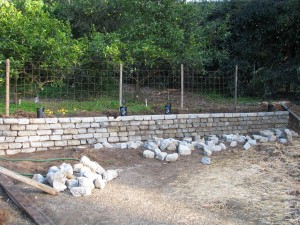
This retaining wall below my raised veggie beds sport a trellis for blackberries made from leftover wire and posts. Still there is leftover cement for more projects. What makes the above endeavors particularly sweet is that it is all about recycled and reused materials. Keep your eyes out for free stuff: bags of clean leaves for compost, broken cement, old logs, etc., for your own garden. Roger is particularly good at it. In fact, today he and I both heard a chipper running in the neighborhood, and wondered what was being chipped. He was far ahead of me, though, and arranged for the company to dump their truckload of palm chips this afternoon, and keep us in mind for more. Its a bad season for Washingtonia palms in my neighborhood! The chips are wet and fiberous, and will only be good for pathways. Tomorrow the heap should be steaming!

Behind the palm mountain is still more broken cement and behind that mushroom compost: all were picked up for free!
This week we are talking to pond guys, carpenters, greywater guys, rock guys and water guys. The ponds are the next big project, and they have to be done right the first time. Stay tuned!
-
Spring Is Here

Spring is here Today I really felt that Southern California had shrugged off Winter. It was warm and a little humid out, my Satsuma plum is in full bloom, and my desert tortoise (endangered species; I’m his third owner and he’s licensed) Homer came out of hibernation in the closet. He’s still sleepy and grumpy, and I can relate to that.

I also saw the first Red Diamondback Rattlesnake today, newly emerged from hibernation, sunning itself in the cleft of a boulder about head height. My hiking buddy Alex and I were at Santa Margarita River Preserve, and there was this somnamulant reptile soaking in the sun and enjoying the radiating warmth of the rock. We posed right next to him or her, and he or she didn’t care. This would not be the case on a hot summer’s day!

This intermediate dry spell is important for the construction of the permaculture garden because the soil is still too wet to allow trucks down on the property. We are investigating the best way to create the ponds, which at this time will incorporate a dry rock creekbed that will catch and channel rainwater and allow it to perculate into the soil, another pond for water holding, and a possible natural swimming pond. The swimming pond works on the same concept as a natural greywater system. Beside the swimming area is another deep area filled with different grades of rock. Water plants which clean water with their roots are planted on top in a naturalistic way. Water is pumped into this area from the bottom, and as the water rises through the gravel and plant roots it becomes clear, then is transported into the swimming area. No chemicals needed; in fact, chemicals would ruin the biological balance of the pond. The swimming pond is clean and ready for human use, and also provides riparian habitat, food and acts as a watering hole for many animals. They are popular in Europe and other countries, and are slowly catching on here in America. Of course, people throughout time have swum in gunky swimming ponds; this is just making one for oneself. This is a YouTube link to a UK pond builder. He is hawking a video on his project, which is only available in the UK and thus wouldn’t play on US DVD players, but this short video tells a lot about swimming ponds: http://www.youtube.com/watch?v=7JoQthEBl6U . Clicking on this link will navigate you away from this page. I just love his Liverpudlian accent.
Today I became the owner of clumping giant bamboo, and a Buddha’s Hand citron. So very cool! The bamboo can be used for all kinds of structures, and with the citron I can make my own candied fruit for desserts. Did you know that candied fruit is called succade? Nope, neither did I.

Creepy, but fun and very fragrant. The fruits are mostly peel, and are used to scent rooms and clothes in Asia. Also planted were various stonefruits, including 4-in-1 apples, apricot, cherry, pear, peaches, nectarines and Asian pear. I also became the proud owner of two little kumquat trees. They are loaded with fruit, and since they were purchased from an organic nursery, this crop doesn’t have to go to waste (you eat kumquats whole).
So, after a morning of Zumba at the Fallbrook Community Center, planting and feeding my many animals, then four hours of intense hiking, my legs are trying to get me to walk upstairs to bed and stay there. Sounds like a good idea to me.
-
Heavy Rains

Heavy rains flood the property During this kind of wet weather I’m rich in water. The above photo is of the middle and lower part of the property as it runs over the edge of the barranca into the streambed below. The palm trunks are left to provide support for a trellis, and the fallen trunks will be used to hold up swales, as furniture, stairs, and whatever else inspiration brings.

Coast Live Oaks and Englemanns. Between showers the sun lit up the oaks that were planted just before the rains set in. This double line of oaks will provide great habitat and should attract many more birds onto the property. The natural clay soil was augmented with mushroom compost, urea from Fallbrook Waste and Recycling, and innoculated with soil microbes. Building up the life underground is key to health, disease-resistance, and water retention. Microbes become attached to roots and not only allow the roots to absorb more water, but release the minerals in the soil so that they are available for the roots to slurp up.
-
First Trees Planted!

Fruit trees ready for planting. Hello! I’m endeavoring to update daily. So much is going on! My existing pond has been filled with Pacific Chorus Frogs doing their part in both maintaining their noisy reputation and continuing their gene pool. Lots of spawn! I can’t clean out the algae until they’ve hatched and metamorphed into frogs, otherwise the mosquito fish will get them.
Anyway, the above photo is of the beginning nursery, where I’ve potted up many bareroot fruit trees and vines so that they are ready to plant. Its at the end of bareroot season here in San Diego, although its the beginning of it elsewhere. Pecans and almonds will be available in May.

A future covered walkway. How exciting is this? I’ve always envied the walkways where the trees grow together overhead, and voila! I have one! A Liquidamber Pathway. Did you know that Liquidamber styraciflua, or Sweetgum, comes in a variety of Fall colors? From dark red to lightest of yellow. What a beautiful Autumn it will be!
Tomorrow rain is predicted with heavy showers on Saturday and temperatures down to the low 20’s. Here in Southern California that spells trouble for our citrus and avocado crops, and all our frost-tender ornamentals. Perhaps on one of the rain days I’ll tell my very creepy waterlily story. Waterlilys creepy? Ohhhh yeahhhhh.
